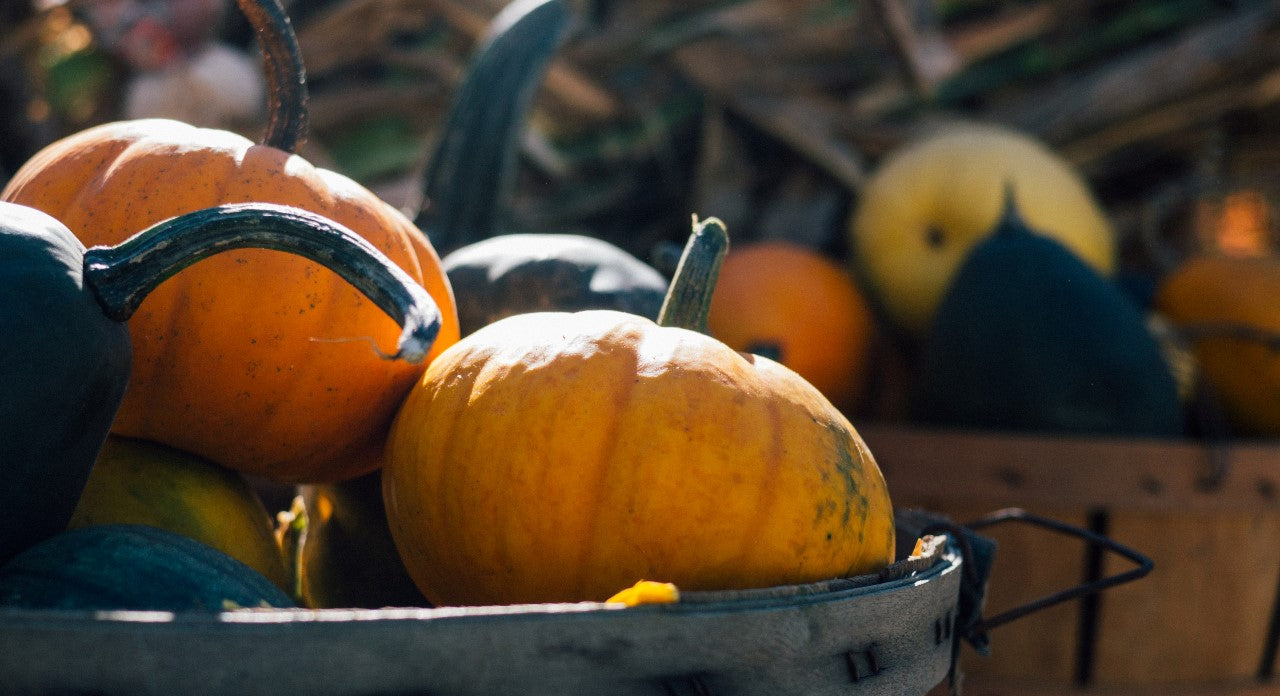
Bien-être 14/09/2020
Raisin de septembre et courge d’octobre : que mettre dans son assiette automnale
Le 21 septembre annonce l’arrivée de l’automne ! Après une année de patience, de nombreux fruits et légumes font leur entrée dans notre cuisine. De la châtaigne au raisin, en passant par les cucurbitacées, chacun s’invite avec ses recettes gourmandes. Pour s’accorder à cette nouvelle phase de l’année, voici ce qu’il faudra cueillir chez l’épicier ou au supermarché.
La cuisine de l’automne prépare l’organisme pour l’hiver et le retour du froid. Ses saveurs sont associées à la terre, qui marque de sa signature les produits qui y poussent. Choux et courges pointent leurs feuilles à la surface de la terre, tandis que les oignons, carottes ou encore navets s’enracinent en dessous. Mais pour bénéficier pleinement des nutriments que les fruits et légumes nous offrent, ils devraient être consommés de saison. Savez-vous pourquoi ?
Pourquoi consommer les fruits et légumes de saison ?
La nature est bien faite : elle contient tout ce dont nous avons besoin au moment où nous en avons besoin. En plus d’être savoureuse et respectueuse de l’environnement, consommer de saison permet aussi de sortir de sa routine gustative et de découvrir de nouveaux aliments, particulièrement riches en minéraux et en fibres lorsqu’ils sont cueillis à maturité.Les fruits et légumes de saison répondent à nos besoins nutritionnels du moment. En automne et en hiver, la nature nous offre des légumes riches en minéraux et des agrumes pleins de vitamine C pour soutenir notre système immunitaire et nous préparer aux grands froids. Inversement en été, avec la chaleur, notre organisme demande plus d’eau. Elle produit donc des fruits et légumes riches en eau, comme le melon, la pastèque, la tomate, la courgette, les fruits rouges, etc.
Ils sont plus riches en antioxydants. Les fruits et légumes de saison contiendraient des taux d’antioxydants jusqu’à 69% plus élevés que les produits stockés ou d'importation. Les antioxydants sont des molécules qui protègent les cellules de notre corps des agressions qu’elles subissent (UV, pollution, tabagisme, etc.), et permettent donc de prévenir l’apparition de certaines maladies et de retarder le vieillissement. Les végétaux en produisent comme mécanisme de défense, essentiellement pour se protéger du soleil. Les fruits et légumes de saison étant cueillis à maturité et stockés très peu de temps, les nutriments sont à leur apogée.
Ils ont plus de goût. Les fruits et légumes qui arrivent à maturité au soleil développent des saveurs que ceux qui mûrissent sous serre ou durant le transport ne peuvent avoir. Les tomates mangées en hiver, par exemple, auront le goût de l’eau…
Ils sont moins traités. Un fruit ou un légume qui n’est pas de saison est généralement produit sous serre, où il a été aspergé de pesticides et autres substances nocives pour l’aider à grandir et compenser le manque de soleil. Mais les végétaux qui poussent en pleine terre ont cette merveilleuse capacité à s’adapter à tous les climats mais aussi à certaines maladies.
Ils sont moins chers. Les produits de saison et locaux demandent moins de transport et pas de taxe d’importation, ce qui se répercute sur le prix.
Dans mon assiette automnale, je mets…
Courge, potimarron, butternut, potiron… : les stars de la saison !
D'octobre à décembre, les cucurbitacées s’invitent dans nos soupes et nos tartes. Revitalisants et stimulants, ces légumes riches en caroténoïdes s’accordent avec une multitude de recettes, de l'entrée au dessert. Outre les traditionnelles soupes et purées, elles sont parfaites poêlées, en gratin, en salade, en crumble, en cake ou encore en spaghettis.
Cousines des courgettes et des concombres, les courges se répartissent gustativement en deux grandes familles. Les courges aqueuses : on les utilise principalement pour faire les soupes. Parmi elles, on retrouve la butternut, le potiron rouge vif d’Etampes et la courge bleue de Hongrie. L’autre grande famille est plutôt farineuse. Elle se tient mieux à la cuisson et il sera plus facile d’en faire des gratins, quiches ou de les rôtir. Vous trouverez le potimarron, la kabocha, la shiatsu… Et puis il y a celles qui sont un peu à part et que l’on déguste différemment : le pâtisson que l’on peut farcir, et la courge spaghetti qui peut être mangée à la manière de spaghetti avec les longs fils qu'elle forme quand on la gratte après cuisson.
Atouts santé : de manière générale, les cucurbitacées possèdent de nombreux composés antioxydants, qui protègent les cellules de notre corps. Elles sont riches, entre autres, en vitamine A, C, B2, fer et manganèse. Leur bêta-carotène est excellent pour la peau et leur richesse en vitamine E protège du mauvais cholestérol.
Astuce : Ne jetez pas vos graines de courge. Vous pouvez les faire sécher puis les rôtir doucement au four pour vos recettes ou à l'apéro, en version sucrée ou salée.
Notre recette gourmande : Curry de butternut et patates douces
Le panais, un légume oublié
Cultivé depuis le moyen-âge, le panais est petit à petit tombé dans l’oubli. Pourtant, ce légume cousin de la carotte a des vertus santé exceptionnelles. D’ailleurs, le mot panais est dérivé du latin « panacem » qui veut dire « remède ». Très riche en vitamines, minéraux, fibres et antioxydants, le panais possède un goût doux et légèrement sucré.
En cuisine, le panais se décline sur une large palette de textures et de saveurs. Il peut se consommer aussi bien cru que cuit : râpé dans une salade avec de la pomme, en purée avec de la patate, en frites, en soupe, en poêlée ou simplement grillé au four. Le panais adore les gratins, les tartes, les quiches, auxquels on peut adjoindre d’autres légumes. Il se marie très bien avec des cèpes, des viandes et des poissons fumés. Vous pouvez également opter pour la fameuse recette irlandaise : le colcannon, mêlant panais, pommes de terre et oignons fondus, le tout gratiné. En version sucrée, on peut l’apprêter en tarte ou en cake.
Atouts santé : Véritable source d’acides foliques, de fibres alimentaires, de vitamines (B1, B5, B6, B9, E, C, K1), de minéraux (potassium, calcium, manganèse, zinc, magnésium) et d’oligo-éléments (sélénium, phosphore), le panais est également préconisé pour ses apports en protéines, glucides et lipides. Très riche en fibres alimentaires, il permet de réguler le transit intestinal. Le panais est un légume contenant des antioxydants particuliers, comme l’apigénine, qui a notamment des vertus anti-inflammatoires. De plus, tout comme la carotte, le panais possède des polyacétylènes, une molécule renommée pour ses actions antibactériennes et anti-inflammatoires.
Astuce : une fois épluchés et lavés, citronnez les panais pour éviter qu’ils ne noircissent.
Notre recette gourmande : Frites de panais au miel et aux épices douces
L’énergie du raisin
Noir ou blanc, le raisin est le fruit idéal pour un grand « nettoyage » avant d’affronter l’hiver. Mais également pour faire le plein de vitamines et de minéraux ! Pour bénéficier pleinement de ses vertus antidouleurs, anti-inflammatoires, antioxydantes, circulatoires, drainantes et diurétiques, il est recommandé de le croquer en entier, pépins compris. Le raisin est un fruit qui absorbe facilement les pesticides dans sa pulpe, il est donc judicieux de l’acheter bio.
En cuisine, le raisin est un fruit qui peut s'utiliser dans des plats sucrés ou salés, en confiture, dans une tarte ou un clafoutis, en salade de fruits ou avec des carottes râpées. Il accompagne également très bien les fromages, les endives, les poissons, la volaille et la viande. On peut également le marier avec des plats plus raffinés comme le foie gras. Les raisins secs, eux, s’intègrent également dans de nombreuses recettes, comme par exemple des cookies, du pain, des pommes farcies aux noix ou un cake à la banane.
Atouts santé : Le raisin recèle une importante quantité de puissants antioxydants de la famille des flavonoïdes (le raisin noir en contiendrait deux fois plus que le blanc), mais aussi de polyphénols nommés resvératrols. Ces antioxydants préviennent l’apparition de certaines maladies cardiovasculaires et sont favorables au mauvais cholestérol. Les polyphénols contenus dans les pépins, ralentissent le vieillissement cutané en protégeant la peau des radicaux libres. Ils renforcent aussi le collagène et l’élastine de la peau. Le raisin est également source de minéraux, d’acides et d’oligo-éléments, comme le phosphore, potassium, calcium, magnésium, soufre, chlore, silice, manganèse, fer, iode, zinc et cuivre, ainsi que des vitamines (C, A, B1, B2, B5, B6, B9, E, PP, P). Ses sucres sont directement assimilables par l’organisme.
Astuce : pour éviter que les raisins secs ne tombent au fond du moule lors de la cuisson d’un cake, il suffit de les rouler dans la farine avant de les incorporer à la pâte.
Notre recette gourmande : Taboulé d’automne aux figues, raisins et crottin de chèvre
La figue fraîche, fruit du soleil
Blanche, noire, verte ou violette, la figue offre une chair onctueuse avec de petits grains craquants et des saveurs douces et acidulées. Elle donne une touche d’originalité à de nombreuses recettes salées ou sucrées, tout en apportant fibres, potassium, cuivre et antioxydants.
Pour bénéficier de ses nombreuses vertus, il est préférable de consommer la figue en fruit de table. Mais elle entre bien sûr dans la préparation de tartes, gâteaux, confitures, salades de fruits, clafoutis ou gratins. On peut la glisser dans des compotes, la pocher dans un vin liquoreux ou la rôtir au four, seule ou avec des pommes. Dans ce cas, elle a sa place aussi bien en dessert que comme accompagnement d’une volaille. Elle se marie aussi aux saveurs salées, comme le fromage de chèvre ou de brebis, ou le jambon de Parme. Sinon, dégustez-la sur une tranche de pain de campagne, relevée de poivre et d’un filet d’huile d’olive, ou parsemez-en vos salades. Sèche, elle se savoure nature ou accompagnée d'amandes ou de noix.
Atouts santé : Si la figue fournit peu de vitamine C, elle est surtout intéressante pour sa teneur en vitamines du groupe B. Riche en vitamine B1 et B3, la figue favorise le métabolisme énergétique puisque la B1 participe à la production d’énergie alors que la B3 en permet la libération selon les besoins de l’organisme. De même, on y trouve aussi de la vitamine B5 en belle quantité qui participe à la santé de la peau et des cheveux mais aussi au bon fonctionnement du système nerveux. La vitamine B6 permet la synthèse de la taurine, reconnue comme ayant une action calmante, et indispensable à la synthèse de la sérotonine, un neurotransmetteur qui régule le cycle veille-sommeil. De plus, la B6 facilite l’assimilation du magnésium. La figue est également riche en calcium et contient une grande variété d’oligo-éléments : fer, zinc, cuivre, iode, phosphore, manganèse, et potassium pour la régulation de la pression artérielle et la prévention des crampes et courbatures. Enfin, la figue est très riche en fibres, elle favorise donc le transit intestinal.
Astuce : Fragile, la figue s’abîme très vite. Conservez-la 24 heures pas plus, à moins que votre fruit ne manque de maturité.
Notre recette gourmande : Figues sauce au caramel au beurre salé et amandes




